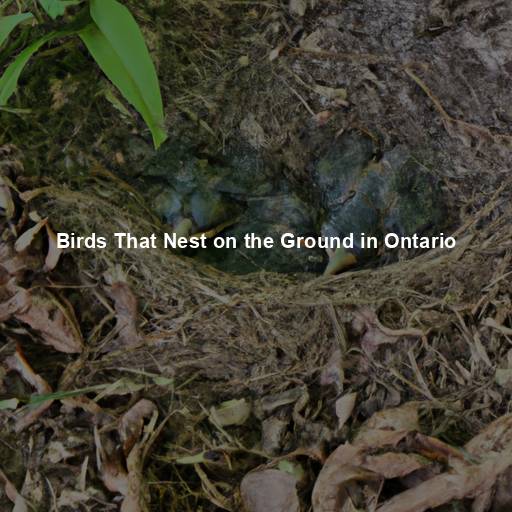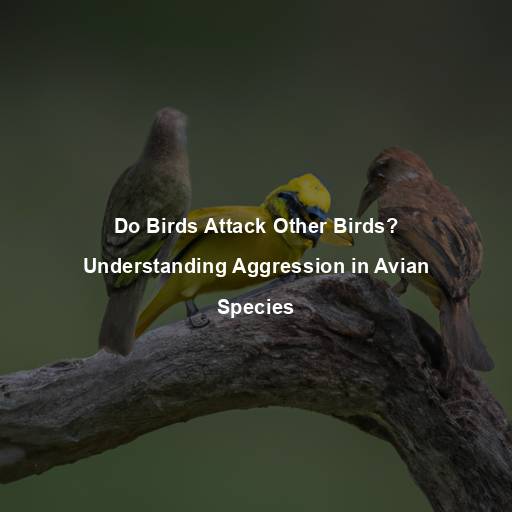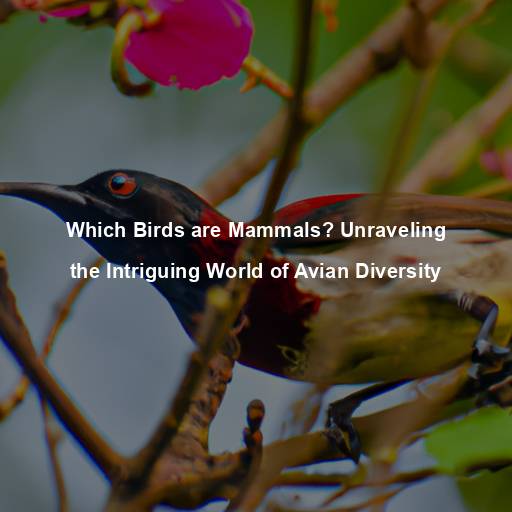Birds That Nest on the Ground in Ontario
Last Updated on November 5, 2023 by Evan
Contents [hide]
- 1 Understanding the Nesting Habits of Ontario’s Ground-Nesting Birds
- 1.1 The Killdeer: A Master of Deception
- 1.2 The Common Nighthawk: A Camouflaged Ground-Nester
- 1.3 The Upland Sandpiper: A Grassland Dweller
- 1.4 The American Woodcock: A Forest Floor Dweller
- 1.5 The Bobolink: A Songbird of the Grasslands
- 1.6 The Savannah Sparrow: A Coastal Ground-Nester
- 1.7 The Eastern Towhee: A Shrubland Resident
- 1.8 Threats and Conservation Efforts
- 1.9 Creating a Safe Haven
- 1.10 Camouflage and Concealment
- 1.11 Protection from Predators
- 1.12 Access to Food and Resources
- 2 Challenges Faced by Ground-Nesting Birds
- 3 Conservation Efforts to Protect Ground-Nesting Birds
- 3.1 Preserving and Restoring Habitat
- 3.2 Implementing Responsible Land Management Practices
- 3.3 Raising Awareness and Engaging Communities
- 3.4 Nest Construction and Site Selection
- 3.5 Nest Placement and Concealment
- 3.6 Incubation and Parental Care
- 3.7 Challenges and Threats
- 3.8 Competition for Resources
- 3.9 Conservation Strategies and Actions
- 3.10 Habitat Preservation and Restoration
- 3.11 Education and Outreach
- 3.12 Predator Management
- 3.13 Collaborative Partnerships
- 4 FAQs: What Birds Nest on the Ground in Ontario?
- 4.1 What bird species nest on the ground in Ontario?
- 4.2 Why do certain birds nest on the ground instead of in trees or nests?
- 4.3 How do ground-nesting birds protect their nests from predators?
- 4.4 Are ground-nesting birds at a higher risk of predation compared to other bird species?
- 4.5 What should I do if I come across a ground-nesting bird’s nest?
- 4.6 Can I provide any assistance to ground-nesting birds in Ontario?
Understanding the Nesting Habits of Ontario’s Ground-Nesting Birds
Birds are such captivating creatures, aren’t they? They go above and beyond when it comes to finding the perfect nesting spot. You might think it’s all about trees or man-made structures, but hold on! There’s a whole other level of nesting happening right on the ground.
The Killdeer: A Master of Deception
The Killdeer (Charadrius vociferus) is a familiar sight in Ontario’s grasslands, meadows, and agricultural fields. This medium-sized shorebird has developed a clever nesting strategy that relies on deception. Instead of building a traditional nest, Killdeer create simple scrapes in the ground, often close to rocks or vegetation. These shallow depressions blend seamlessly with their surroundings, making them difficult to spot.
The Common Nighthawk: A Camouflaged Ground-Nester
The Common Nighthawk (Chordeiles minor), a bird known for its distinctive aerial displays and crepuscular habits, is another ground-nesting species found in Ontario. These birds prefer open areas such as gravel rooftops, sandy beaches, or even bare ground. Their mottled gray and brown plumage provides excellent camouflage, helping them blend seamlessly into their environment.
The Upland Sandpiper: A Grassland Dweller
The Upland Sandpiper (Bartramia longicauda) is a grassland bird that finds its home in Ontario’s prairies, meadows, and pastures. Unlike many other ground-nesting birds, the Upland Sandpiper constructs a more elaborate nest by forming a shallow depression and lining it with grasses. This species is particularly sensitive to habitat loss and requires vast tracts of undisturbed grasslands for successful nesting.
The American Woodcock: A Forest Floor Dweller
The American Woodcock (Scolopax minor) is a ground-nesting bird that inhabits moist forests and thickets across Ontario. These birds have a unique mating display, where males perform a mesmerizing aerial dance at dusk. After mating, the female creates a small nest on the forest floor, often concealed under dense vegetation or fallen leaves. Their cryptic coloring helps them remain hidden from predators.
The Bobolink: A Songbird of the Grasslands
The Bobolink (Dolichonyx oryzivorus) is a migratory songbird that breeds in Ontario’s grasslands and meadows. Male Bobolinks are easily recognizable with their striking black and white plumage, while females sport a more subdued brown coloration. These ground-nesting birds build cup-shaped nests hidden in dense grasses, providing protection for their precious eggs.
The Savannah Sparrow: A Coastal Ground-Nester
Behind the curtain of nature’s grand theater, in the secret corners of Ontario’s coastal grasslands and marshes, a delicate symphony arises from the wings of the Savannah Sparrow. With stealth and artistry, these diminutive songbirds orchestrate their homes in the embrace of the earth, tucked away in the luxurious embrace of grassy clusters and low-lying vegetation. The intricate design of their nests, a harmonious tapestry of interwoven fibers, creates a sublime sanctuary that both shelters and merges seamlessly with the ethereal coastal backdrop.
The Eastern Towhee: A Shrubland Resident
Have you ever stumbled upon the enigmatic Eastern Towhee while exploring the enchanting landscapes of Ontario? This elusive ground-nesting bird, scientifically known as Pipilo erythrophthalmus, holds a captivating presence in the shrublands and forest edges of the region. In their quest for nesting sites, these avian artists display an inherent affinity for thickets, shrubby areas, and the mysterious tangles of vegetation. Marvel at the female’s remarkable craftsmanship as she weaves a tapestry of grasses, leaves, and twigs, fashioning a resilient sanctuary to safeguard her precious eggs and nestlings from the whims of nature.
Threats and Conservation Efforts
The delicate dance of survival unfolds for ground-nesting birds, as they navigate through a web of challenges that threaten their very existence. Dishearteningly, the loss of their natural habitat, often replaced by the concrete sprawl of urban development, is a formidable foe. The relentless encroachment of agriculture and the relentless march of invasive species only serve to further deepen the sense of peril. To add an ominous twist to this already perilous plight, lurking in the shadows are predators of the mammalian variety, sly raccoons and cunning foxes, ready to unleash their insatiable appetite upon these unsuspecting birds and their precious nests.
Conservation efforts play a vital role in safeguarding the habitats of ground-nesting birds. Protecting and restoring grasslands, wetlands, and shrublands are crucial steps in preserving these species. Avoiding disturbances in nesting areas during the breeding season and promoting responsible land management practices are essential for their survival.
Creating a Safe Haven
Ground-nesting birds have evolved to build their nests on the ground for various reasons. This nesting strategy provides them with several advantages, including camouflage, protection from predators, and easier access to food sources. By selecting specific habitats, these birds can create a safe haven for their eggs and nestlings.
Camouflage and Concealment
The decision of ground-nesting birds to build their cozy homes on the ground stems from a remarkable ability to seamlessly blend into their environment. These avian architects exhibit a splendid display of plumage that matches the intricate colors and patterns of the surrounding foliage or terrain. Such ingenious camouflage serves as a protective shield, rendering their nests elusive and elusive to potential predators. This remarkable adaptation significantly enhances the likelihood of their offspring flourishing into adulthood, embracing the beauty of survival in the perplexing realm of the animal kingdom.
Protection from Predators
Ground-nesting birds must contend with a plethora of concerns in their quest for a safe habitation. Amongst the cacophony of potential dangers, the ever-looming presence of predators poses a serious threat. Yet, in a puzzling twist of fate, these birds have developed an intriguing solution: they defy conventional wisdom by nestling their homes on the very ground that harbors their adversaries. It is in this unconventional choice that they find a glimmer of hope, as their nests become shrouded in a cloak of secrecy and misdirection.
Access to Food and Resources
Ground-nesting birds often select habitats that offer easy access to food and other necessary resources. For example, the Upland Sandpiper prefers grasslands and pastures where it can find insects and seeds abundant in these environments. By choosing suitable nesting habitats, these birds ensure a steady supply of food for themselves and their young.
Challenges Faced by Ground-Nesting Birds
Habitat Loss and Fragmentation
One of the most significant threats to ground-nesting birds is the loss and fragmentation of their habitats. As human activities continue to encroach upon natural areas, grasslands, wetlands, and shrublands, which are crucial nesting habitats for many species, are being destroyed or degraded. This loss of suitable nesting sites puts immense pressure on ground-nesting bird populations.
Predation
Ground-nesting birds face an ongoing battle against predators constantly lurking in the shadows. From cunning raccoons to sly foxes and prowling domestic cats, these mammals pose a formidable threat to the delicate ecosystems these birds call home, causing their populations to plummet. The situation worsens as invasive species like European Starlings and House Sparrows not only muscle in on the already limited nesting sites but also vie for vital resources, adding an extra layer of complexity to the perplexing challenges these vulnerable birds endure.
Disturbance and Nest Destruction
The breeding season of ground-nesting birds is a time of great vulnerability, where disturbances can wreak havoc on their delicate nesting behaviors. Everyday human activities, like leisurely pursuits, changes to their natural habitats, and even agricultural practices, can disrupt this crucial stage of their lives. Surprisingly, even well-meaning actions, such as unsuspectingly venturing through their nesting grounds or giving our canine companions too much freedom in these areas, can have disastrous consequences on the overall population of these birds.
Conservation Efforts to Protect Ground-Nesting Birds
Preserving and Restoring Habitat
Preserving and reviving vital habitats is an absolute necessity for the survival of ground-nesting birds. The protection of grasslands, wetlands, and shrublands, whether by acquiring land or implementing conservation easements, plays a crucial role in maintaining suitable nesting grounds for these feathery creatures. It is equally important to embark on restoration initiatives that seek to revive or improve deteriorated habitats, as they can potentially unlock additional nesting prospects and breathe new life into their environments.
Implementing Responsible Land Management Practices
Promoting responsible land management practices is crucial for the long-term conservation of ground-nesting birds. This includes avoiding habitat destruction and fragmentation, minimizing disturbances during the breeding season, and implementing sustainable agricultural practices that consider the needs of these species. Collaborative efforts between landowners, conservation organizations, and government agencies are essential for the success of these initiatives.
Raising Awareness and Engaging Communities
When it comes to the protection and conservation of ground-nesting birds and their habitats, one thing is clear: raising awareness is crucial. By offering educational programs, workshops, and citizen science initiatives, we can captivate communities and ignite a sense of responsibility towards these unique creatures. By empowering individuals to actively participate in monitoring, reporting nest sightings, and restoring habitats, we can pave the way for a collective effort in safeguarding the future of these remarkable species. It’s time to embrace the burst of passion and perplexing wonder that these birds bring to our world.
Nest Construction and Site Selection
When it comes to constructing their nests, ground-nesting birds can be quite the architects. Each species has its unique approach, leaving one in awe of the diversity in their construction methods. From the Killdeer’s humble scraping of a shallow hollow to the Upland Sandpiper’s intricate weaving of grasses, these feathered builders never fail to surprise. The true marvel lies in their knack for hiding these nests, whether blending seamlessly into their surroundings or carefully choosing concealed corners of their habitat.
Nest Placement and Concealment
How ground-nesting birds go about choosing their humble abodes never ceases to amaze. Their meticulous selection process involves scouting out the perfect hideaway amidst an abundance of foliage and natural obstacles like rocks or thick clusters of grass. By seamlessly assimilating into their surroundings, these avian architects tap into their protective instincts, ensuring their vulnerable nests remain undetected by potential predators. It’s a survival strategy that truly underscores nature’s marvels.
Incubation and Parental Care
Once the eggs are laid, ground-nesting birds take turns incubating them to regulate temperature and protect them from potential harm. Both males and females participate in incubation duties, with some species, like the American Woodcock, employing a unique strategy where the female incubates while the male guards the nest. This shared responsibility ensures the survival of the eggs and allows the parents to forage for food.
Challenges and Threats
Ground-nesting birds face numerous challenges that impact their nesting success and overall population health. These challenges include habitat loss, predation, disturbance, and competition for resources.
Competition for Resources
Invasive species, such as European Starlings and House Sparrows, can outcompete native ground-nesting birds for nesting sites and resources. These invasive species often nest in cavities or man-made structures, further reducing the availability of suitable nesting habitats for ground-nesting birds. Competition for limited resources can have negative impacts on the reproductive success and population dynamics of these vulnerable species.
Conservation Strategies and Actions
Efforts to protect and conserve ground-nesting birds require a multi-faceted approach that addresses both the preservation of their habitats and the mitigation of threats they face.
Habitat Preservation and Restoration
Protecting and reviving vital environments like grasslands, wetlands, and shrublands holds immense significance in the battle to ensure the survival of ground-nesting birds. This entails adopting land management strategies that uphold and improve the availability of suitable nesting spots, encompassing the safeguarding of current habitats and the inception of fresh initiatives geared towards revitalizing these essential ecosystems.
Education and Outreach
Did you know that ground-nesting birds are in need of our attention and protection? These incredible creatures and their habitats are facing challenges that require the collective efforts of all individuals. Through educational programs, community engagement, and citizen science initiatives, we can empower people to become stewards of these birds and take action to protect their homes. By encouraging the public to actively participate in monitoring and reporting nest sightings, as well as promoting responsible land use practices, we can make a tangible difference in conserving these precious species.
Predator Management
Finding effective ways to mitigate predation on ground-nesting birds is a complex challenge that requires strategic planning. By implementing targeted predator control measures in designated areas, such as protected nesting sites, we can alleviate the pressure on these vulnerable birds and enhance their chances of survival. However, it is crucial to approach predator management with caution, relying on scientific research to avoid any unforeseen repercussions.
Collaborative Partnerships
Collaboration between various stakeholders, including landowners, conservation organizations, researchers, and government agencies, is essential for the successful conservation of ground-nesting birds. By working together, sharing knowledge, and implementing coordinated conservation actions, we can maximize the impact of our efforts and ensure the long-term survival of these remarkable species.
FAQs: What Birds Nest on the Ground in Ontario?
What bird species nest on the ground in Ontario?
Ontario’s grounds become a haven for an assorted ensemble of avian inhabitants. Among them are the audacious Killdeer, the elusive American Woodcock, the secretive Wilson’s Snipe, the majestic Ruffed Grouse, and the charming Eastern Towhee. These feathered beings have astutely honed their survival skills, opting for ground-based nesting and employing an array of unique tactics to safeguard their precious offspring from the world’s perplexing perils.
Why do certain birds nest on the ground instead of in trees or nests?
Birds that nest on the ground have evolved to do so for various reasons. Some species have specific habitat requirements, such as open grasslands or wetlands, where ground nesting is more advantageous than nesting in trees. Nesting on the ground also provides certain benefits like camouflage and protection from predators, particularly if the adults can utilize distraction displays or aggressive behaviors to deter threats.
How do ground-nesting birds protect their nests from predators?
The world of ground-nesting birds is a fascinating one, where survival tactics take center stage. These clever creatures have honed the art of camouflage, seamlessly blending into their surroundings like nature’s own disappearing act. But that’s not all – they’ve mastered the art of misdirection too, employing strategic distractions and theatrics to keep predators on their toes. Some even go the extra mile by selecting nesting spots cloaked in a veil of thick foliage or nestled beside shimmering water bodies, leaving predators perplexed and scratching their heads. Truly, the avian world never fails to intrigue and amaze!
Are ground-nesting birds at a higher risk of predation compared to other bird species?
Ground-nesting birds face higher predation risks compared to birds that nest in trees or shrubs. Their nests are more exposed and accessible to predators like raccoons, skunks, foxes, and snakes. However, their nesting strategies have evolved to mitigate these risks. By choosing suitable habitats, employing protective behaviors, and relying on camouflage, ground-nesting birds have increased their chances of successfully raising their young despite higher predation pressures.
What should I do if I come across a ground-nesting bird’s nest?
Discovering a ground-nesting bird’s nest provides a precious glimpse into the wonders of nature. To safeguard the nest and its precious inhabitants, it is crucial to tread lightly with a delicate balance of respect and caution. The key is maintaining a respectful distance, refraining from lingering around the nest’s vicinity, as this may unsettle the fragile equilibrium. It’s equally important to ensure that our furry companions remain leashed and far away, minimizing any potential harm or disruption. By embracing the beauty of these nests from afar, we grant these devoted parents the space they need to gracefully fulfill their innate duties, preserving the magic of their natural interactions undisturbed.
Can I provide any assistance to ground-nesting birds in Ontario?
While it is important to respect the natural behaviors and habitat requirements of ground-nesting birds, you can indirectly support them by preserving their nesting habitats. Protecting grasslands, wetlands, and other suitable habitats from habitat loss and degradation ensures these bird species have suitable areas to nest. Similarly, being mindful of your actions in these habitats, such as avoiding trampling or disturbing nesting areas, can help in the conservation of ground-nesting bird populations in Ontario.







